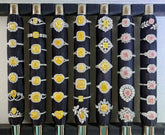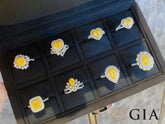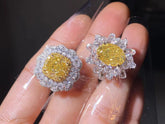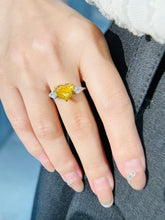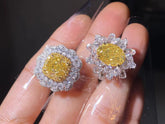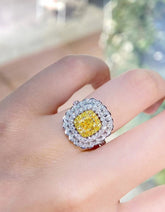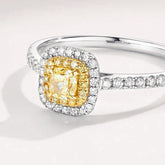The wallet is a bit tight, but still want to buy colored diamonds. How to solve this?

'The King of Gems' is undoubtedly the diamond, while the 'King of Colored Gems' is the colored diamond, according to the consensus in the international jewelry industry.
As ordinary working people, how can we afford our first colored diamond? We suggest that everyone should act within their means and avoid being overly ambitious.
Next, let's explore which type of colored diamond is affordable for us. Of course, for those with substantial financial resources, you can also consider aiming for the status of 'King of Colored Diamonds.'
Are there no 'affordable and good quality' colored diamonds?

The answer is: Yes, but essentially, the cheap ones are not attractive, and the attractive ones are unaffordable, leading to this unsolvable cycle.
Colored diamonds are extremely rare in nature, accounting for less than 0.01% of the world's total diamond production (less than one in ten thousand). Additionally, nature produces some colors much more frequently than others, so the chance of finding a diamond in a color that humans prefer may be as low as one in a million.
Generally, the rarer the color of a colored diamond, the more expensive it is. However, fortunately for those of us with tight budgets, a small number of naturally colored diamonds are priced roughly the same as or even lower than normal D-Z colorless diamonds.

Bennifer 2.0

Bennifer 2.0' refers to the second engagement of the big stars Jennifer Lopez and Ben Affleck. This event in the entertainment industry has once again brought green diamonds into the spotlight, so let's focus on this color first. Spoiler alert: green diamonds are extremely rare.
Who makes green diamonds 'green'?

Green color in diamonds is typically caused by exposure to atomic radiation, although the presence of nitrogen, hydrogen, or nickel atoms can also result in green coloration. Because most natural green diamonds also exhibit yellow, blue, or gray hues, diamonds that are purely green are highly valuable. In 2016, the 5.03-carat vivid green diamond 'Aurora Green' sold at Christie's auction for $16.2 million.
How do diamonds get their other colors?

Before delving into the causes of natural diamond colors and whether you can afford them, it's important to understand how the world of gemstone colors operates. Because the human eye can distinguish approximately 13 million colors and their subtle differences, gemologists have developed a consistent method for charting the correct position of gemstones in the vast color universe.
Pink and red diamonds

We can first establish that, like green diamonds, red and pink diamonds are distinct. Unlike most natural diamond colors caused by chemical elements, natural red and pink diamonds derive their color from structural defects.
Natural red and pink diamonds form due to a phenomenon called plastic deformation. They compress their lattice in a certain way under extreme pressure during their growth, allowing them to transmit red light. The greater the pressure, the greater the deformation, and the higher the color saturation. This is why only small carat weights are found in red diamonds, as the pressure that gives them their highly saturated color also inhibits their growth.

Purple diamond
 s
s
Most natural purple diamonds get their color from the presence of hydrogen, and pure purple diamonds are extremely rare.
Green Diamonds

To reiterate, the green color of diamonds is typically caused by exposure to atomic radiation, although the presence of nitrogen, hydrogen, or nickel atoms can also result in green coloration. Humans can produce green laboratory-grown diamonds using electron beam radiation. In 2018, consumer concerns about irradiated diamonds and colored gemstones led the U.S. Nuclear Regulatory Commission to state, 'The Commission has no reason to believe that wearing irradiated gems could be harmful. There have been no reports of harm from wearing them or any other irradiated gem.'
Blue Diamonds

Rare blue diamonds contain trace amounts of boron in their crystal structure. Boron absorbs yellow light, giving us the blue color.
Yellow and Orange Diamonds

Yellow, orange, and brown diamonds all come from the most common non-carbon atom in diamonds, nitrogen. The color appears yellow when nitrogen absorption is observed at low wavelengths. When it occurs at higher wavelengths, the color becomes orange (with exceptions). Brown is also caused by nitrogen and may be further influenced by plastic deformation.
Grey Diamonds

The color of most natural grey diamonds comes from hydrogen, and sometimes boron.
Black Diamonds

Some black diamonds have high levels of inclusions, approaching industrial quality, while others are considered special... standout black diamonds, known as carbonado, are found in alluvial deposits in Brazil and Central Africa. These places are unrelated to kimberlite, the usual source of diamonds, making these black diamonds a mystery.
An article published in the December 2006 edition of The Astrophysical Journal Letters reported finding trace amounts of hydrogen in carbonado diamonds. The details of this discovery suggest that these black diamonds existed long before Earth was formed, originating from outer space.
Which color is cheaper?
Economical Colors:
For natural color diamond enthusiasts on a tighter budget, there's a comforting fact: they typically offer better value for money compared to colorless diamonds in the D-Z range. Among them, yellow diamonds are the most expensive, comparable in price to colorless diamonds with VS clarity and G color. These colors include:
Black Diamonds
Grey Diamonds
Brown Diamonds
Yellow diamonds with saturation lower than Fancy Intense.
Slightly Expensive Colors:
Here, 'slightly expensive' refers to the various levels of color saturation and secondary hues—meaning diamonds with secondary tones that diminish their value. For example, brownish-orange, yellowish-orange, etc. Some colors in the 'extremely expensive' list can also be obtained at relatively lower prices, depending on their secondary hues, which could be multiple. These colors include:
Yellow diamonds with saturation greater than Fancy.
Orange Diamonds.
Expert Tip:
When considering diamonds of any hue, remember that deeper tones often better hide inclusions. This can bring many deep and dark colored diamonds into practical consideration because they can remain eye-clean at lower clarities compared to their counterparts in light, medium, strong, and vivid color levels.
Exorbitant Colors:
The following colors, with moderate purity, size, and saturation, are often sold through auction houses. Prices per carat start high and increase rapidly with improved clarity, carat weight, and color saturation. They are:
Purple Diamonds
Pink Diamonds
Green Diamonds
Blue Diamonds
Irrelevant Colors to Us:
In terms of price and value for natural diamonds, other colored diamonds are incomparable to red diamonds. For example, the ring pictured, set with a 2.09-carat heart-shaped red diamond provided by Moussaieff, sold at Christie's in 2014 for a world auction record of $5,095,872, equivalent to $2.44 million per carat.
———— / END / ————
